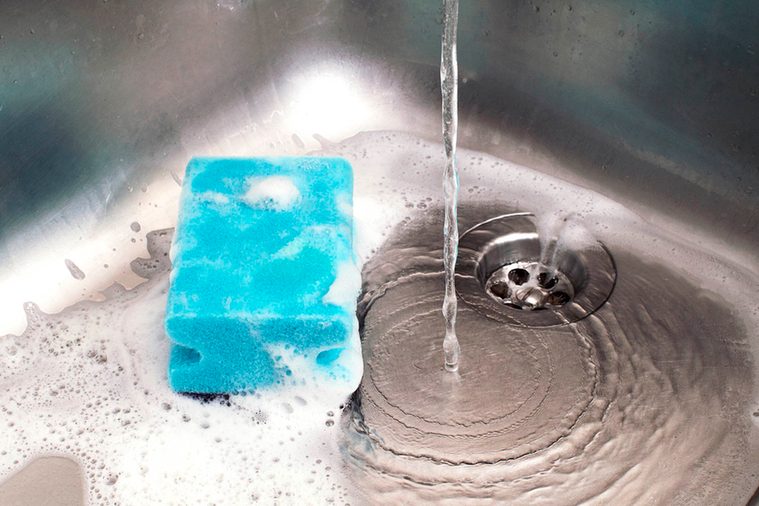This One Item Has More Bacteria Than Anything in Your Entire House—and Cleaning It Doesn’t Make a Difference
Updated: Aug. 08, 2017
The domestic abomination is literally teeming with germs.
 If you cringe at the thought of eating your chicken meatloaf off a toilet seat, we guarantee this will absolutely petrify your inner germaphobe. While you may expect the germiest item in your home to be the toilet seat, the most dangerous culprit is actually a household staple that seems far more innocent. (Here are 9 other everyday items that seem dirtier than a toilet seat.)
If you cringe at the thought of eating your chicken meatloaf off a toilet seat, we guarantee this will absolutely petrify your inner germaphobe. While you may expect the germiest item in your home to be the toilet seat, the most dangerous culprit is actually a household staple that seems far more innocent. (Here are 9 other everyday items that seem dirtier than a toilet seat.)
A new study published in Scientific Advances by a team of German researchers have revealed that the most bacteria-riddled area in your house is the kitchen sponge. In a comprehensive study of 14 household sponges and its microbial inhabitants, their results showed that the dense material (that you literally rub all over your plates every day) colonizes about 54 billion bacterial cells.
“Despite common misconception, [past research has] demonstrated that kitchen environments host more microbes than toilets,” the paper notes. “This was mainly due to the contribution of kitchen sponges, which were proven to represent the biggest reservoirs of active bacteria in the whole house.”
Kitchen sponges proved to be the ultimately ideal breeding grounds for microbes because of its nourishingly warm and moist environment, coupled with the food remnants that are plastered on its surfaces. The porous nature of kitchen sponges and its liquid-absorbing capacity makes them the ideal storage space for tiny living organisms.
 The researchers authenticated this conclusion by studying the microbiome of the built environment, with a particular interest in places with humans interact with on a daily basis. Understandably, their primary suspects were the bathrooms and kitchens. By DNA-sequencing 28 samples from 14 sponges, they found a whopping (and very disconcerting) 118 different kinds of bacteria in total.
The researchers authenticated this conclusion by studying the microbiome of the built environment, with a particular interest in places with humans interact with on a daily basis. Understandably, their primary suspects were the bathrooms and kitchens. By DNA-sequencing 28 samples from 14 sponges, they found a whopping (and very disconcerting) 118 different kinds of bacteria in total.
A small percentage of their findings did include a number of pathogenic bacteria, the type that has potential to make humans sick. Examples stretched from campylobacter and salmonella to staphylococcus and E. coli—all of which can cause mild to severe gut and skin infections. Here are 10 other things in your house that could be making you sick.
Even if you think you’re using the proper hygienic practices—aka rinsing it and using some soap afterwards—it’s nowhere near as powerful to fully eradicate the vibrant party of bacteria and fungi reveling in those nasty sink-dwellers. Even after sanitizing the sponges, new bacterial colonies were reported to inevitably resurface.
“No [sanitization] method alone seemed to be able to achieve a general bacterial reduction of more than about 60 percent,” the authors wrote. “Our data showed that regularly sanitized sponges (as indicated by their users) did not contain less bacteria than uncleaned ones.”
In the end, the authors do put out a disclaimer that there is more work to be done and that “whether this has any consequences in terms of clinical relevance remains to be demonstrated,” but the work does highlight their hopes to “create even more awareness for kitchen sponges as hygienically relevant microbial incubators.”
Before you jet off to the kitchen to expunge all your kitchen sponges, there are potential methods to prevent your sponge from inciting your next bout of food poisoning. As the study proves, a simple toss through a dishwasher cycle or a scalding run in the microwave will be a pointless effort. If anything, this can rapidly recolonize the festering fungi. Your best bet is tossing your sponge into a vat of bleach solution; this is potent enough to kill anthrax spores, which can reduce your risk of catching something. But if you want to stay on the safe side, the experts recommend just switching out your kitchen sponge on a weekly basis. These are the 15 other things you should be replacing more often.


















